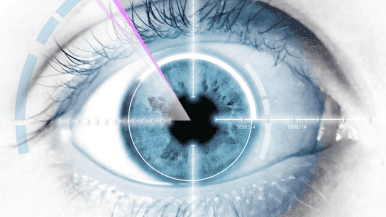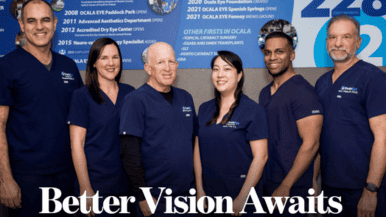The wonders of modern technology and laser eye surgery, often referred to as LASIK or PRK, have made it possible for many people to improve their eyesight and quality of life. In fact, the benefits of laser vision correction seem incredibly bright (pun intended).
So, how can lasers help you see better, and what should you expect after the procedure?
LASIK and PRK: The Standards in Laser Vision Correction
The two main laser corrective techniques used today are photorefractive keratectomy (PRK) and laser-assisted in-situ keratomileusis (LASIK).
Approved by the FDA in 1995, PRK was the first successful laser vision correction technique which involved directly altering the corneal curve, without the use of a covering flap. PRK is still frequently performed, but LASIK has become the more popular laser technique employed today, mainly because of its quicker recovery time.
LASIK is also a laser procedure to correct vision errors; it can correct nearsightedness [myopia], farsightedness [hyperopia], and/or astigmatism. LASIK has evolved from previous procedures like PRK, and is by far the most commonly performed laser vision correction procedure today.
The details distinguishing LASIK from PRK can easily be confusing to the layperson until fully explained by a trained professional. The difference between LASIK and PRK, is that in PRK the laser is applied directly to the surface of the eye to reshape it, whereas in LASIK a thin flap is created, then lifted, followed by the laser to reshape the inner cornea underneath the flap. The advantages of LASIK over PRK are that with this thin flap, the recovery of vision is much faster and there’s minimal if no discomfort at all, compared to PRK.
After the PRK procedure, the outer layer of the cornea requires additional time to heal properly; patients normally wear a temporary soft contact lens for comfort for a few days and need prescription eye drops for several weeks after surgery to prevent infection and inflammation. Peak vision typically occurs four to six weeks after the procedure.
There are, however, special instances where PRK will be preferable to LASIK. Indications for a surface ablation procedure such as PRK or Epi-LASIK instead of LASIK include significant dry eye, scarring of the surface of the eye, thin corneas or occupational hazards such as boxing or mixed martial arts.
How Successful is the LASIK Procedure?
The main challenge of evaluating the success of a procedure is defining what is success. As far as a successful procedure, LASIK borders on a 99+% success rate, defined as the ability to function well in all aspects of life without the need for glasses or contact lenses. But every patient has different definitions of what success is: Can I drive without glasses? Can I go hunting without glasses? Can I play golf without glasses? In the vast majority of cases the answer is a resounding YES!
Every day new patients are experiencing what it feels like to be free of glasses or contact lenses. Just ask William Krysalka, a recent patient at Ocala Eye, who was considered legally blind before his procedure: “When I healed, my vision was perfect. Just where I wanted it. They nailed it,” he says. “I can now enjoy my favorite hobby, archery, without glasses.”
“The change has been magnificent,” says Janine Madison, another happy patient at Ocala Eye. “It’s wonderful. I have no worries about reading street signs, (and) I’m more confident.”
For certain patients, not having to wear glasses for the first time in their life can change their self-image. Patients can see like they’ve never seen before. Many patients affirm that it’s the best thing that’s ever happened to them.
Is Laser Vision Correction for Everyone?
So, can anyone reap the benefits of LASIK? Almost.
Due to certain key factors, there is a specific age range that is best-suited for LASIK. The age range of LASIK is approximately 20 to 55 years old. Eye surgeons don’t usually treat before age twenty to ensure that the eye is fully mature and that the refraction or the prescription of the patient is stable. At the other end of the spectrum, beyond age 55, one commonly begins to see aging changes in the lens which are known as cataracts. If a cataract is present, LASIK is no longer the best procedure to correct vision.
Some exceptions do exist, and, if on examination, there are absolutely no signs of cataracts, LASIK may still be appropriate. Whatever the case, the team at Ocala Eye works with patients to discuss and explain all of the options and possibilities before making an informed decision.
What is Monovision LASIK?
LASIK is usually a distance vision correction procedure but patients over the age of 40 will still need reading glasses after LASIK. One way to get around this is to perform what’s called monovision, where one eye is set for distance and the other eye for near. Many patients over age 40 are able to do this successfully and will find that they don’t need any glasses most of the time.
More than 90% of females do great with monovision and more than 75% of men. However, it may affect depth perception so there are certain occupations, such as pilots, that are not the best candidates for monovision; but it can be a very good option for some patients who don’t want to use reading glasses after the age of 40.
The Ocala Eye Family
At Ocala Eye, LASIK is more than surgery, it’s an experience, provided by a staff of highly-skilled, compassionate medical professionals who care about their patients’ best interests.
Our team of LASIK surgeons get to know their patients, understand each individual’s vision needs, and uniquely plan the treatment to meet those vision goals. At Ocala Eye, LASIK is about helping patients improve quality of life and at the same time achieve a level of satisfaction that comes only with true vision freedom.
Most patients tell us the day after surgery that they got up in the morning and reached for their glasses on the night table, and then realized…that they didn’t need them anymore.




